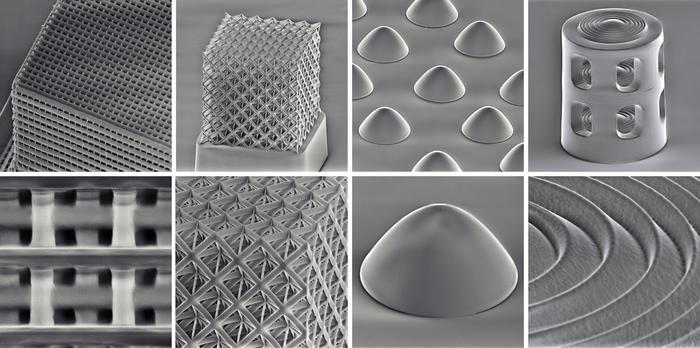Printing of micro- and nanometer-scaled quartz glass structures from pure silicon dioxide opens up many new applications in optics, photonics, and semiconductor technologies. So far, processes have been based on conventional sintering. Temperatures required for sintering silicon dioxide nanoparticles are above 1100°C, which is much too hot for direct deposition onto semiconducting chips. A team headed by Dr. Jens Bauer from KIT’s Institute of Nanotechnology (INT) has now developed a new process to produce transparent quartz glass with a high resolution and excellent mechanical properties at far lower temperatures.

Credit: Dr. Jens Bauer, KIT
Printing of micro- and nanometer-scaled quartz glass structures from pure silicon dioxide opens up many new applications in optics, photonics, and semiconductor technologies. So far, processes have been based on conventional sintering. Temperatures required for sintering silicon dioxide nanoparticles are above 1100°C, which is much too hot for direct deposition onto semiconducting chips. A team headed by Dr. Jens Bauer from KIT’s Institute of Nanotechnology (INT) has now developed a new process to produce transparent quartz glass with a high resolution and excellent mechanical properties at far lower temperatures.
Hybrid Organic-inorganic Polymer Resin as Feedstock
Bauer, who heads the Emmy Noether Junior Research Group “Nanoarchitected Metamaterials” at KIT, and his colleagues from the University of California, Irvine and the Edwards Lifesciences company in Irvine present the process in Science. They use a hybrid organic-inorganic polymer resin as the feedstock material. This liquid resin consists of so-called polyhedral oligomeric silsesquioxane (POSS) molecules, which are small cage-like silicon dioxide molecules equipped with organic functional groups.
After cross-linking the material via 3D printing to form a 3D nanostructure, it is heated to 650°C in air to remove the organic components. At the same time, the inorganic POSS cages coalesce and form a continuous quartz glass microstructure or nanostructure. The temperature required for this purpose is only half the temperature needed for processes based on sintering of nanoparticles.
Structures Remain Stable Even under Challenging Chemical and Thermal Conditions
“The lower temperature enables the free-form printing of robust, optical-grade glass structures with the resolution needed for visible-light nanophotonics, directly on semiconductor chips ,” Bauer explains. Apart from an excellent optical quality, the quartz glass produced has excellent mechanical properties and can be processed easily.
The researchers from Karlsruhe and Irvine used the POSS resin to print various nanostructures, including photonic crystals of free-standing, 97 nm wide beams, parabolic microlenses, and a multi-lens micro objective with nanostructured elements. “Our process produces structures that remain stable even under harsh chemical or thermal conditions,” Bauer says.
“The INT group headed by Jens Bauer is associated with the 3DMM2O Cluster of Excellence,” says Professor Oliver Kraft, Vice President Research of KIT. “The research results now published in Science are only one example of how early-stage researchers are successfully supported in the cluster.” 3D Matter Made to Order, or 3DMM2O for short, is a joint Cluster of Excellence of by KIT and Heidelberg University. It pursues a highly interdisciplinary approach by combining natural sciences and engineering. It is aimed at raising 3D additive manufacture to the next level – from the level of molecules up to macroscopic dimensions.
Original Publication:
J. Bauer, C. Crook, and T. Baldacchini: A sinterless, low-temperature route to 3D print nanoscale optical-grade glass. Science, 2023. DOI: 10.1126/science.abq3037
For the abstract, click https://www.science.org/doi/10.1126/science.abq3037
Information on the 3DMM2O Cluster of Excellence: https://www.3dmm2o.de
Information on the Nanoarchitected Metamaterials Laboratory: http://nanoarchitects.org
Being “The Research University in the Helmholtz Association”, KIT creates and imparts knowledge for the society and the environment. It is the objective to make significant contributions to the global challenges in the fields of energy, mobility, and information. For this, about 9,800 employees cooperate in a broad range of disciplines in natural sciences, engineering sciences, economics, and the humanities and social sciences. KIT prepares its 22,300 students for responsible tasks in society, industry, and science by offering research-based study programs. Innovation efforts at KIT build a bridge between important scientific findings and their application for the benefit of society, economic prosperity, and the preservation of our natural basis of life. KIT is one of the German universities of excellence.
Journal
Science
DOI
10.1126/science.abq3037
Method of Research
Experimental study
Subject of Research
Not applicable
Article Title
A sinterless, low-temperature route to 3D print nanoscale optical-grade glass
Article Publication Date
1-Jun-2023
COI Statement
The authors declare no competing interests.




